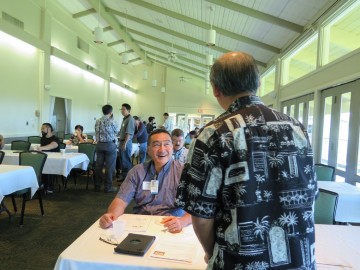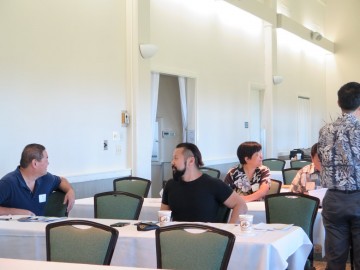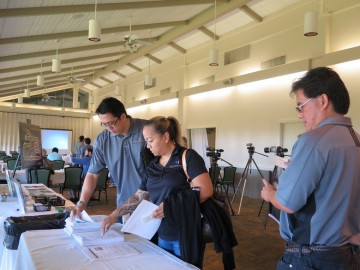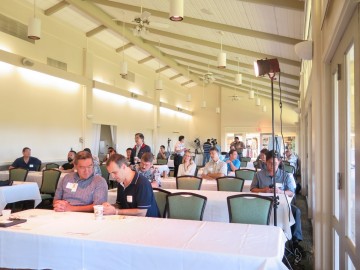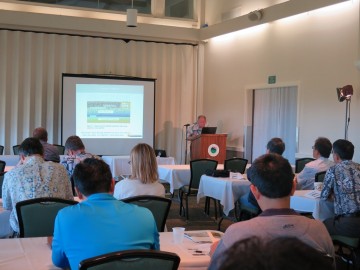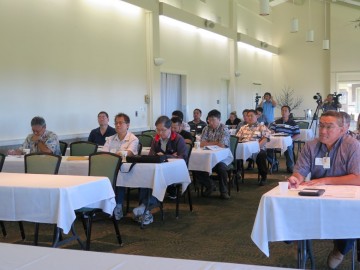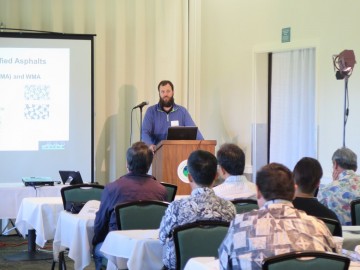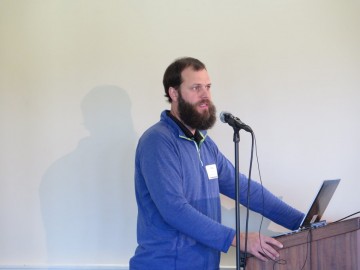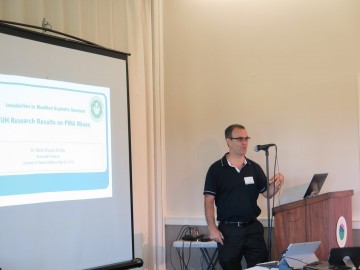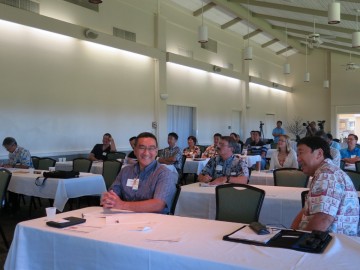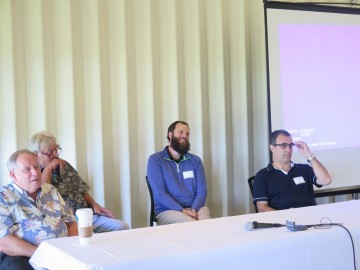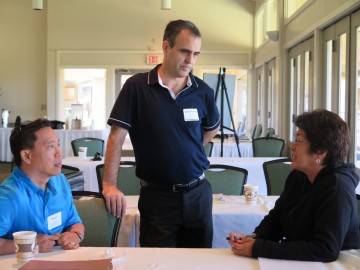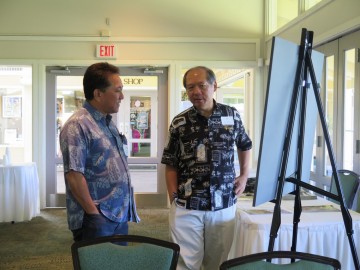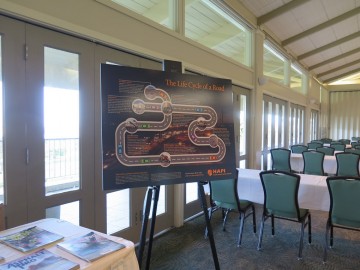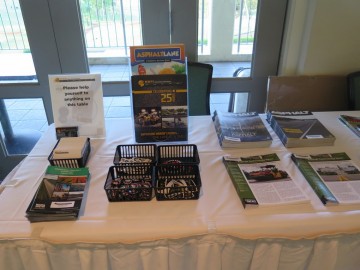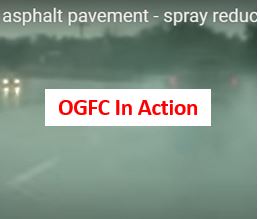Attendees from design consultants and government agencies heard presentations from a group of industry experts. Follows is a bullet point summary of their presentations:
Rich Gribbin discussed pavement mix types and uses of modified asphalts in Hawaii:
- Mix Types: Dense Graded, Stone Matrix Asphalt (SMA), and Open-Graded
- Where have they been used: airfield pavements (dense graded), H-1 Freeway Rehabilitation (SMA); harbors (SMA); Big Island (OGFC)
- Future uses: continued use for application mentioned above, plus use of porous asphalt for roads and parking lots, and fuel resistant asphalt for airfields
Chris Lubbers gave us lessons in Modified Asphalt 101 and SBS-Modified Asphalt 101:
- Started to modify asphalts to reverse the decline in in pavement performance
- Explained the SuperPave asphalt binder specification (i.e. PG 64-16)
- Provide a rule of thumb: If the Useful Temperature Interval (UTI), which the difference between the minimum and maximum temperature range of the binder, is greater than 92, it is a modified binder. For example, PG 76-22 has a UTI of 98; it is a modified binder.
- There are several asphalt modifiers, with Styrene Butadiene Styrene (SBS) being the most widely used.
- Asphalt pavement mixes that use a modified binder have several benefits, including an increase in the life of the pavement.
Richard Levins shared his experiences in the binder industry and the current status of modified asphalts in Hawaii:
- The Kalaeloa Asphalt Terminal has two large tanks. Each store about 150,000 barrels (~24,00o tons) of liquid asphalt binder.
- The liquid asphalt binder is currently imported from Spain.
- The modified binder used in Hawaii is produced at the terminal using SBS modifier.
- The H-1 Freeway Rehabilitation projects done in 2014, was the first project in Hawaii to use a locally produced modified binder.
- Modified binders have been used on the Big Island. Oil heated tanks are required to transport modified binder between islands.
- The terminal can produce a 100 ton batch of modified binder.
Dr. Archilla presented his study for the HDOT Airports:
- Review of the research being done on polymer modified asphalt (PMA) mixes at the University of Hawaii at Moana.
- Presented 2008 Study Highlights for the Dynamic Modulus, Binder Testing, Fatigue, Permanent Deformation, and Life Cycle Cost Analysis.
- Presented the Study for the HDOT Airports Division – Cantabro Test.
- Conclusion: PMA can enhance the performance of mixes with respect to major distresses such as rutting, fatigue cracking, and raveling.
The seminar closed with a question and answer panel discussion.
About our guest speakers:
Rich Gribbin serves as the Statewide Manager – QC/QA for James W. Glover, Ltd. A long-time Hawai’i contracting and material supply company (ABC license #3). He has chaired HAPI’s Technical Committee and is currently the sitting senior contractor HMA technician on the committee.
Chris Lubbers currently serves as technical sales and market development manager for emulsions in Kraton Polymers’ Paving and Roofing business unit headquartered in Houston, TX. Chris has spent the past fifteen years in the asphalt industry, primarily focused on polymer-modified emulsions and hot-mix paving binders as well as polymer-modified roofing membranes.
Richard Levins has many years of experience in various roles for the asphalt industry. He is currently the President of Asphalt Hawaii, the local supplier of asphalt binder in Hawaii.
Dr. Ricardo Archilla is an Associate Professor from the University of Hawaii at Manoa’s College of Engineering. His area of specialty in transportation engineering include: Transportation Infrastructure Management Systems, Pavement Engineering, Deterioration Modeling, Transportation Systems Analysis, Transportation Systems Analysis, Applied Statistics, and Traffic Engineering.
What are some of the things attendees remembered most about the seminar?
- As someone who will likely just see mixes as a submittal, using the useful temperature interval (UTI) to determine if the mix has been modified will be a useful tool.
- The test results showing the benefits of modified asphalt.
- Definitions or “take-aways” were emphasized and then described in “layman” terms, which helped understanding.
- The information provided was outstanding.
- How the SBS polymers work.
- It’s an option in Oahu now.
Click here for a list of the attendees
Photos:
- Guest Speaker Rich Gribbin
- Guest Speaker Chris Lubbers
- Guest Speaker Richard Levins
- Guest Speaker Dr. Archilla
- Panelists
- A question for the panelists
- Life Cycle of a Road Exhibit
- HAPI Giveaways
- HAPI Giveaways

